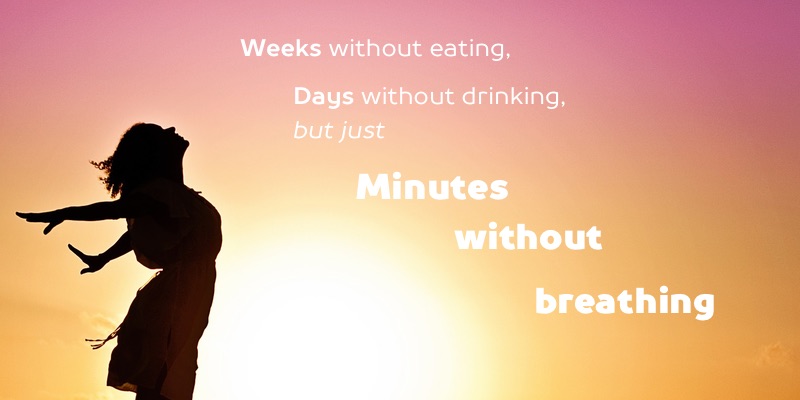Stressed out, under-slept or life pressures like wtf?!? We all know those moments, and luckily we all have the perfect tool always with us to help our body relax - our breath. Learn how you can use your breath to calm down.

“I know how to breath” is the first reply you get from people when telling them to breathe for relaxing. It is innate; we do not even think about it. It just happens without us doing much to control it. Usually, we do not think about our breathing. But it is our life elixir; if we do not breathe, we die.
“Weeks without eating, days without drinking, but just minutes without breathing.” – Unknown
We can survive for a few minutes without breathing. How long depends on the individuum; Apnea divers can hold their breath for up to 12 minutes; the World record is at almost 12 minutes. But most of us can not. The good thing is, we have control over our breath to some extent and can learn breathing patterns which help us. Unfortunately, many people just shallow breath into their chest and do not think about breathing at all.
When we start to breathe deeply into our lungs, our mind and body get more oxygen. And our nervous system starts to calm down, switching from your sympathetic nervous system to your parasympathetic nervous system. The parasympathetic nervous system controls our rest, relax and digest body responses. When it is dominant our heart rate drops, our breathing gets slower and our blood pressure too. We are going into a state of calm and rest.
The sympathetic nervous system on the other hand is responsible for our fight and flight responses. Our heart rate and breathing speeds up and we are ready for action; be it running away from a tiger (btw bad idea), your pissed off boss or by the crowd on the Yamanote Line during rush hours. The threat does not matter.
When we escaped or won our nervous system turns the sympathetic down, because the stress is over, and turns the parasympathetic on, we can relax and refresh.
For many people, the sympathetic does not turn down, and they keep stuck. When the sympathetic nervous system can not shut down or only for short periods, it gets unhealthy for us. We can die from stress as we can die from getting no sleep.
The best part is, we can help our parasympathetic nervous system to turn on with deep breathing. And we can use it also do prevent the sympathetic nervous system from kicking in too early.
For a good breathing pattern, try always to inhale through your nose and exhale through your mouth.
We are also inhaling into our abdomen and not the chest. You need to feel your navel moving up and down.
The 3-6 breathing is a variation of regular deep breathing, but you exhales twice as long as you inhale. Inhale for a count of 3 and exhale for a count of 6. Watch the Video by Dr. Anna B. Baranowsky which gives an excellent intro introduction to the technique.
In Systema, a Russian martial arts system, you learn to adjust your movements to the breathing and also changing your breathing, so your movements benefit. At all time you are not without breath and should not gasp.
Whatever you do keep breathing in a controlled pattern and the movement is initiated by your breath. The first step into it is an exercise combining breath and walking.
It does not matter with which foot you start. Try to walk slowly at the beginning; you can later experiment with walking and breathing speed.
Your breath should lead your physical activity all the time.
Deep breathing helps you to calm down almost instantly and leave you refreshed afterward. It relaxes us, and the oxygen intake makes us ready for action. It can also help us to perform better and prevent us from getting stressed too easily.
Us it, practice it, and you will get results.
So take a deep breath and relax.